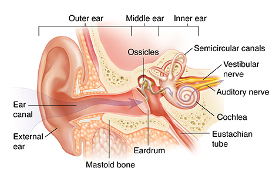Blog
A common myth surrounding hearing problems is that they are something only older people have when, in reality, they can affect anyone regardless of age. In fact, around 48 million people in the United States have trouble hearing, whether with one ear or with both ears. Taking care of your ears and hearing is something that is really important to make sure you are doing, especially if you are around loud sounds. Many people have hearing-related problems and, while it may not seem like it, lots of sounds from your day-to-day life can be damaging to your ears and overall hearing ability. In this post, we will start by going over a little bit about what makes up your ear and how it functions. Then we will talk about some ways to avoid and prevent damage to your ears and hearing.
Ear Anatomy and Physiology
Your ear is responsible for letting you hear sounds and also allowing you to balance. When it comes to your ear anatomy, or the parts that make up your ear, there are lots of different components. These components function together. The outer ear, which is also known as the external ear, is made up of the pinna or auricle. This is the part of your ear that you can grab with your hands or see on the outside of your body easily. You can also see the ear canal, which is the tube that extends from your outer ear to the middle ear. At the end of this tube is your eardrum–also referred to as the tympanic membrane. Behind this, you have a space that has some little bones. These little bones are called ossicles and the three different names for them are as follows: malleus, incus, and stapes. When sound waves come into your ear, they vibrate these bones. These sound waves travel easily because of something called the eustachian tube, which helps with pressure. Finally, there is the inner ear region. The inner ear has the cochlea and semicircular canals. The cochlea looks a bit like a snail and has nerves in it that help you hear. These nerves help tell your brain what different sound waves are and what they mean. The semicircular canals are what help you balance. So, now that you know all of this, how exactly do you hear? The answer is that the sound waves hit your eardrum. Your eardrum will vibrate and then the ossicles vibrate, which helps all the sound information get to your cochlea. Here, the nerves take over and send impulses to the brain. Your brain perceives this as sound.
How to Protect your Hearing
Now that you know all about what makes up your ear and how hearing works, we will talk about some things you can do to protect your hearing.
(1) Be aware of loud sounds. If you click on this link from the Centers for Disease Control (CDC), you can explore what loudness means and how to know when sounds are too loud: https://www.cdc.gov/nceh/hearing_loss/infographic/. This interactive infographic will let you experiment with various daily sounds from whispering to sirens and fireworks. This is a very neat resource and helps you learn about how to tell when noises are too loud. Oftentimes you will not experience any pain even if you are damaging your ears, which is why knowing what sounds are too loud is key to improving your hearing safety.
(2) Control the volume level on your devices. Now that you know what sounds are too loud and damaging to your ear, you can know how to best adjust the audio you listen to throughout the day. Try to lower the volume on your earbuds, earphones, headphones, headsets, and/or speakers. This will help protect your delicate ear structures and prevent hearing damage.
(3) Take breaks from noise. If you are around a lot of noise, make sure to also set aside some time to enjoy the quiet and give your ears a break. If you have a job in a loud setting, it might be good to have a set of earplugs to use if you are allowed to. Whether you take a break from loud noises or use something like earplugs, these things help give your ears a chance to recover as much as they can.
(4) Talk to your healthcare provider. Try to see your healthcare provider once a year. Medical professionals can check on your hearing and your ear anatomy to make sure that everything looks healthy and is working as it should be. Medical professionals can also give you good advice on what to do if something does not seem quite right or if something feels wrong with your ears and hearing.
Learning about what your ears are made up of, how your ears work, and how to take care of your ears is one part of making sure you stay healthy and well. This information is crucial to know because once there is damage to your ears, this damage is not reversible. Certain parts of your ear cannot heal themselves once they have been damaged, and prevention is key! Once your hearing is gone, it is gone for good. The good news is that there are a lot of resources and ways that you can keep your ears functioning at their best.
Sources
3 Reasons Why Ear Protection Is Important
Anatomy and Physiology of the Ear
Hearing Loss Infographic
Be Proactive With Your Hearing Safety
5 Ways to Protect Your Hearing
This blog post was written for Healthy Young NV by Lauren, a High Sierra AHEC Student Ambassador. Lauren is currently studying Microbiology & Immunology at the University of Nevada, Reno; she will also graduate with a minor in Philosophy.



